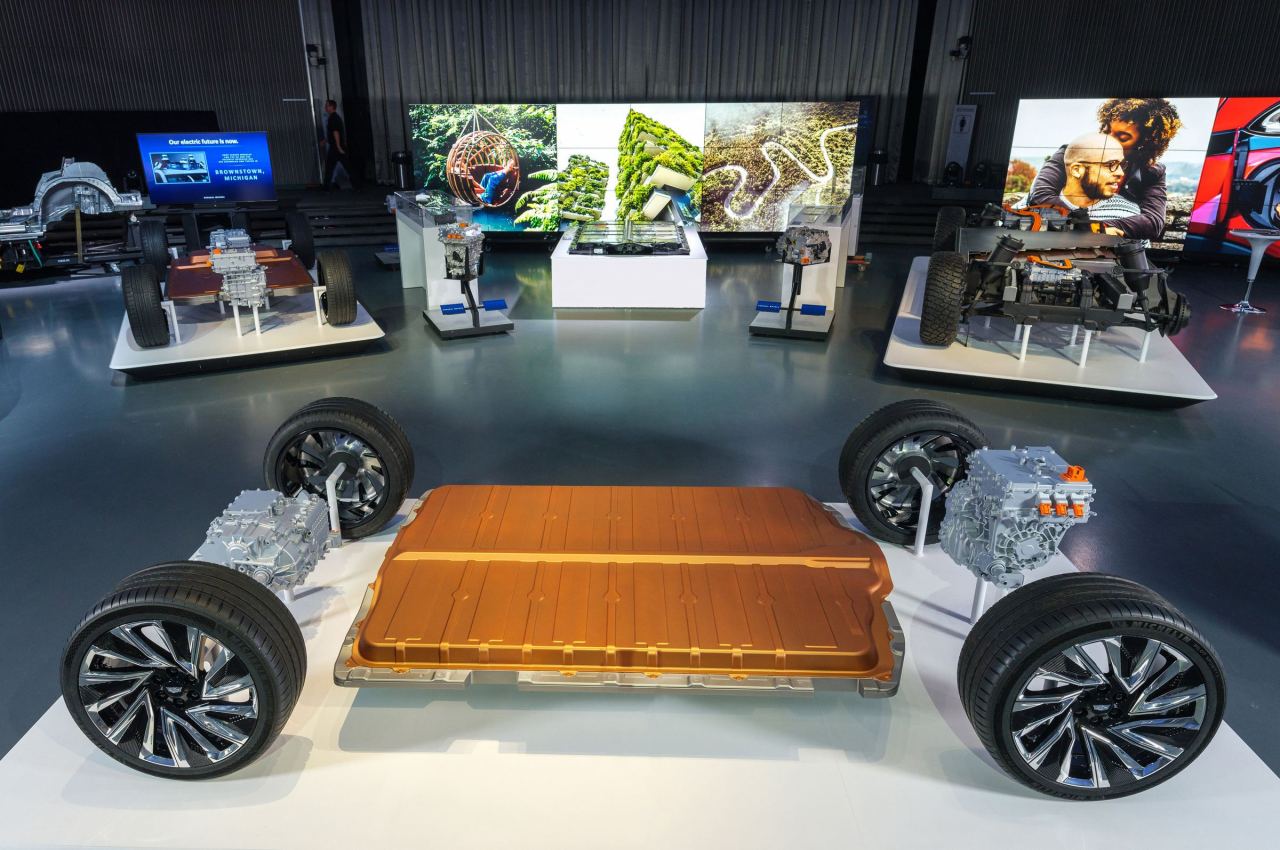 |
From left: GM International President Steven Kiefer, GM Vice President of Autonomous and Electric Vehicle Programs Ken Morris, GM’s Executive Chief Engineer Adam Kwiatkowski and GM’s Architectural Chief Engineer for Autonomous and Electric Vehicle Programs Jesse Ortega. (General Motors) |
Global automakers have been striving to make progress in developing their own platforms and battery systems for electric vehicles that can be applied to all brands for efficiency and cost reasons.
Detroit-based automaker General Motors has a presence in 60 markets with 11 plants, including a major research and development center in South Korea.
The US automaker is betting big on its latest battery system called Ultium which was unveiled in March, to be applied in different markets while also “future-proofing” the energy storage system, according to the company’s top executives.
The in-house EV propulsion system is built to support all of its EV lineups.
 |
GM’s battery system for electric vehicle called Ultium (General Motors) |
“It can be tailored to vehicle and customer needs by stacking common components, like toy bricks, allowing us to increase scale while giving us flexibility,” said Adam Kwiatkowski, GM’s executive chief engineer, during a global conference call interview on June 17.
GM International President Steven Kiefer, GM Vice President of Autonomous and Electric Vehicle Programs Ken Morris and GM’s Architectural Chief Engineer for Autonomous and Electric Vehicle Programs Jesse Ortega were also present at the call.
According to Kwiatkowski, the key building blocks of GM’s new EV architecture are large-scale high energy cells, which will become a common denominator of GM’s entire vehicle lineup.
“We have deep experience in this space from EV1 to EREV to Bolt, given the 25 years of EV experience. Our battery options can vary from 50 to 200 kilowatt hours, enabling GM’s estimated range of over 640 kilometers on a full charge,” he said.
The Ultium system starts with a highly integrated front drive unit, and the efficient design has reduced the number of high voltage connections by 57 percent, Kwiatkowski explained. He said GM has worked on the development of the battery system for roughly three years.
“This gives us the ability to serve the needs of different markets and customers while also future-proofing the energy storage system. When new technology and chemistry become available we can grow or change the module while preserving the overall battery architecture.”
According to GM Vice President of Autonomous and Electric Vehicle Programs Ken Morris, Ultium cells will be manufactured at its new plant in Ohio through a joint venture with South Korean battery provider LG Chem.
“GM is always looking to improve the battery technology that will provide a greater balance of mileage and charging time and expects to get close to the million-mile range in the next few years,” said Morris.
In recent months, the automotive firms have started a race to develop their own million-mile battery as the current EV batteries typically last 100,000 to 200,000 miles.
Last month, Tesla has revealed a partnership with Chinese battery maker CATL, planning to introduce its own million-mile battery later this year at earliest.
When asked whether LG Chem will be also involved in the development of the million-mile battery, Morris said there is no news about future plans yet, but the US firm wants to rather now focus on producing Ultium battery cells in partnership with the Korean company.
With regard to making EVs in Korea, the top executive said GM will leverage GM global EV properly to expand its presence in the domestic market.
“One-fourth of engineers from the big engineering function at the GM Technical Center of Korea can work to develop EV technology. And it is anticipated (that they will have) an important role to realize GM’s technological vision for the future,” said Morris.
GM’s Architectural Chief Engineer for Autonomous and Electric Vehicle Programs Jesse Ortega pointed to Korea’s market strength.
“The fact that (the Korean market) is very urban and technologically advanced with tech-savvy customers gives us an opportunity to do that. You’ve got a strong infrastructure from IT. They’re very well versed in EV and then the team that we have complied there over the last six years is really, really committed to making EV development a reality.”
While Chevrolet Bolt, launched in 2017 with high hopes as one of the first EV models here that can travel a long distance, it initially got a lukewarm reception. GM said changes are being seen with the expansion of the vehicle’s marketing coupled with growth of relevant infrastructure and government incentives.
“Our newly launched 2020 Bolt EV, which will offer 414 kilometers per charge, will again get us a lot of coverage hopefully. And will also provide an incentive. We have strong confidence in the Bolt EV’s technical advantage,” said Ortega.
The 2020 Bolt EV can travel 31 kilometers longer than the previous model, the longest distance compared to other models in the same segment.
According to GM, it plans to launch new EV models for each of its brands including Chevrolet and Cadillac, expanding its EV portfolio to comprise 22 models by 2023.
 |
A rendered image of interior of Cruise, a shared electric self-driving vehicle that GM unveiled earlier this year. (General Motors) |
“(Our future products) are going to continue to lead innovation in the market. We believe the team has expanded our position in Korea with more EVs in the future, and will continue to leverage our global portfolio. So I’m optimistic,” said Ortega.
“We believe in a future of zero crashes, zero emissions, and zero congestion, and we’re building toward this all-electric future because we really believe that climate change is real. We have the expertise to deliver exceptional EVs and drive ownership experiences for our customers,” Kiefer added.
By Kim Da-sol (
ddd@heraldcorp.com)







![[Exclusive] Hyundai Mobis eyes closer ties with BYD](http://res.heraldm.com/phpwas/restmb_idxmake.php?idx=644&simg=/content/image/2024/11/25/20241125050044_0.jpg)
![[Herald Review] 'Gangnam B-Side' combines social realism with masterful suspense, performance](http://res.heraldm.com/phpwas/restmb_idxmake.php?idx=644&simg=/content/image/2024/11/25/20241125050072_0.jpg)

